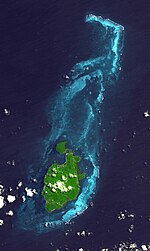


The Seaflower was a sailing ship (likely a fluyt) built in England. Regarded as sister ship to the Mayflower, the Seaflower also transported settlers to the New World, specifically to Jamestown, Virginia, colony in 1621.[1][2] It was most notable for helping settle Puritans on the Caribbean Providence Island colony in 1631.[3][4]
Seaflower frequented Bermuda (then known as the Somers Isles), and some time before 20 March [O.S. 30 March] 1622, the ship was accidentally sunk by a gunpowder explosion in the cabin.[5] Apparently the explosion was caused by the captain's son mishandling lighted tobacco in the gun room.[6][additional citation(s) needed]
It was carrying supplies for a Virginia relief mission.[7][additional citation(s) needed]
Records indicate that the a second ship was named Seaflower after the c. 1622 destruction of the previous. It is unknown whether the first or second ship were distinctly different in design or construction. In 1629, Privateer Captain Daniel Elfrith (aboard the Robert) scouted the archipelago of "Santa Calatina" for riches and as a staging point for Spanish ship plundering.[8] The Earl of Warwick was looking for a new location to build a colony, yielding the setup of Providence Island Company.[9]Inc. February 1631, 100 men and boys (mostly Puritans recruited from Essex, England) boarded the Seaflower, sailing from Deptford to Providence Island.[10] Ninety passengers settled the island in c. May 1631,[11] intending to load the ship with exotic plants and produce for profit in London.[12]
Seaflower returned to London in March, 1632. It was attacked-at-sea by Spanish during the return voyage, with Captain John Tanner and crew narrowly escaping. The ship's cargo was only a small cargo of poor quality tobacco.[13] Later, the Seaflower returned to Providence Island and was loaded again, this time with 1 tonne (1,000 kg) of "mechoacan potatoes" (Ipomoea purga) for their medicinal value.[14]
In autumn 1676, the Seaflower was still in use as a transport for slaves from Africa to the Caribbean.[15] During and after King Phillip's War, the Seaflower was used to transport Native Americans as slaves to Bermuda and other Caribbean colonies.[16][17]
In 1696, notorious pirates Henry Every and Joseph Faro most likely[note 1] used the ship during their time in and around Rhode Island.[19][20]
The Marine Protected Area and Biosphere Reserve surrounding the islands is named after the ship.[21][22][additional citation(s) needed]